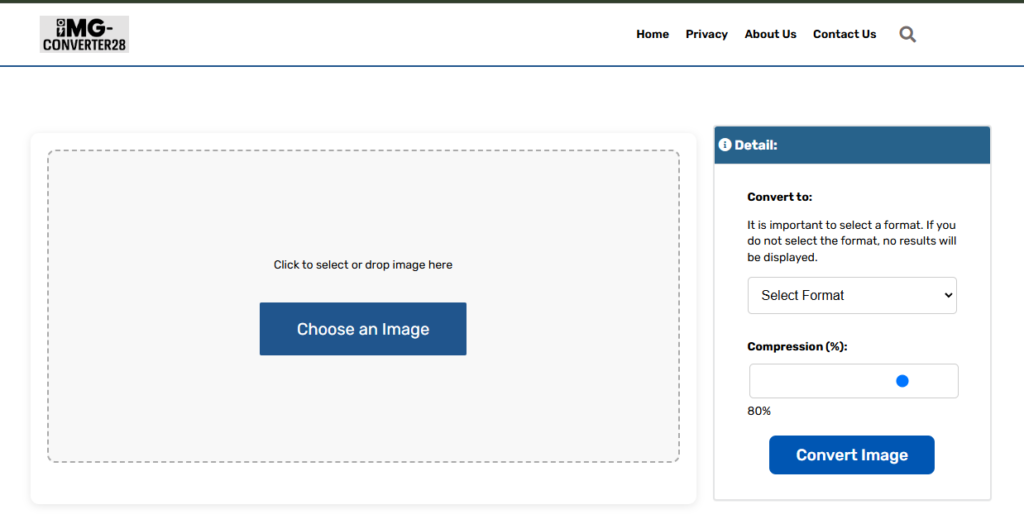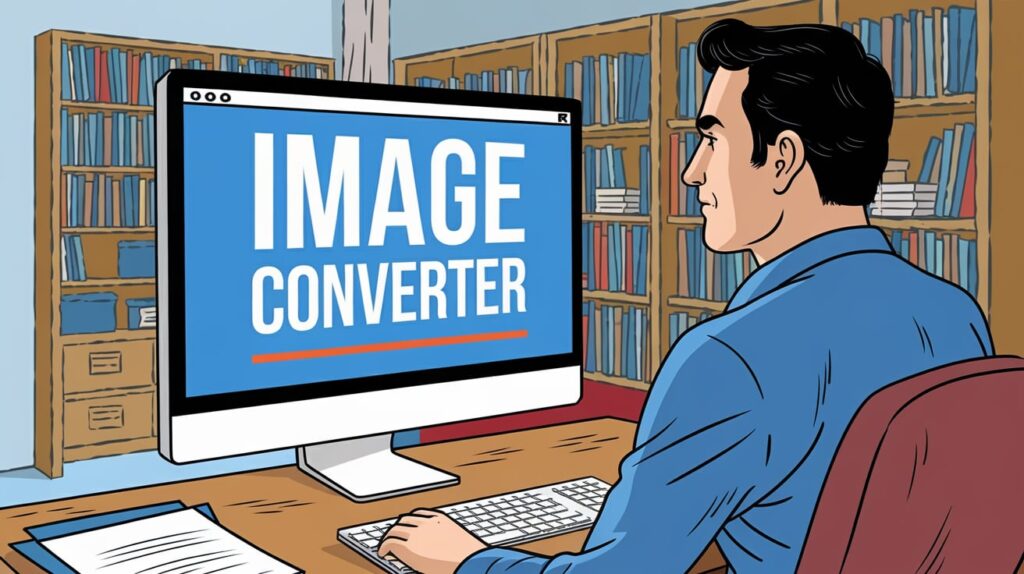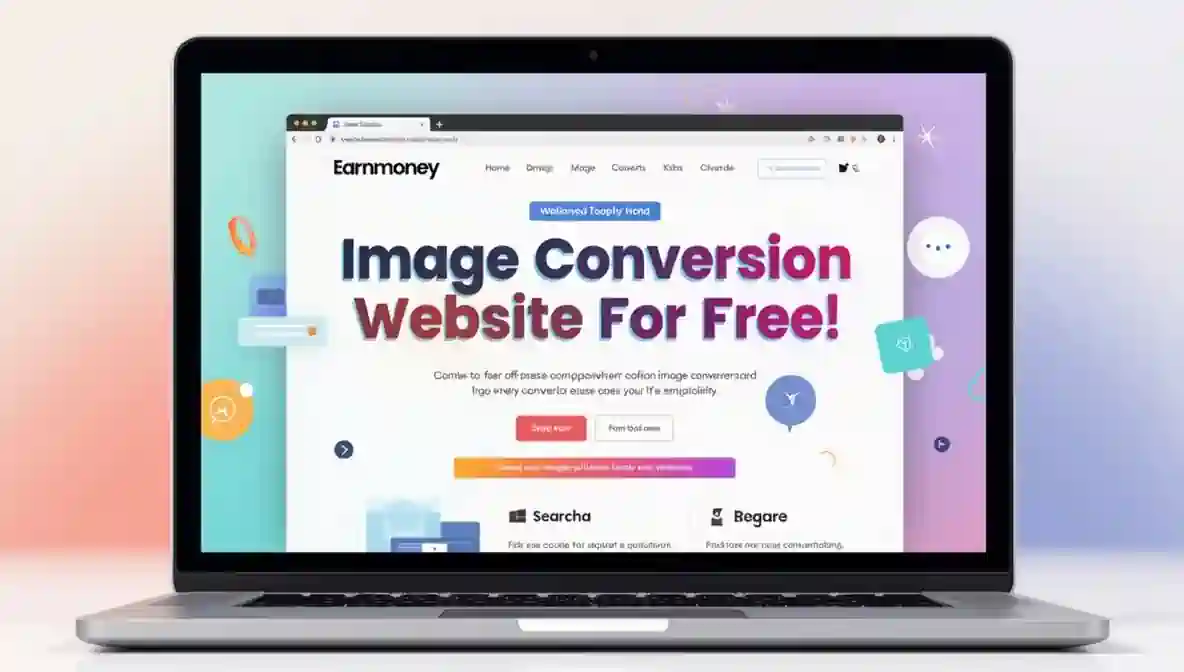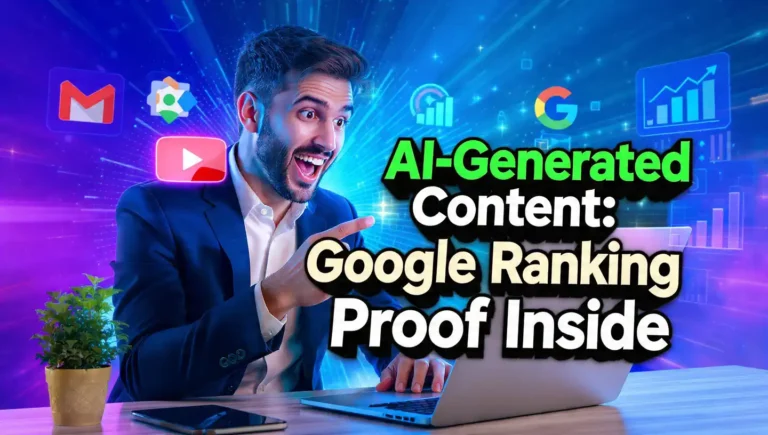How to Create an Image Conversion Website on Blogger for Free ✓ Earn money ! image converter website

Introduction to image converter website
In image converter website the modern digital landscape, image format changer websites have become increasingly vital tools for both casual users and professionals. These platforms enable individuals to convert images from one format to another, catering to diverse requirements such as storage efficiency, compatibility, and quality retention. The most common image formats include JPEG, PNG, GIF, and BMP, each serving unique purposes and exhibiting distinct characteristics. For instance, JPEG is widely regarded for its compact size, making it ideal for photographs on websites, while PNG supports transparency, making it suitable for graphic design and web graphics.
The necessity of converting images between formats cannot be understated, especially as users accumulate vast libraries of digital media. Different applications may prefer or require specific formats; for instance, GIFs are popular for short animations on social media platforms, whereas PNGs are often favored for web use due to their lossless compression attributes. Consequently, an image format changer website offers invaluable assistance by simplifying the process of format conversion, effectively catering to the evolving needs of users.
Furthermore, the significance of these websites extends beyond mere convenience. They serve a critical function in optimizing images for enhanced web performance, ensuring that graphics load quickly without sacrificing quality. As websites increasingly emphasize user experience and speed, an image format changer can help webmaster reduce load times by converting images to more efficient formats. Additionally, users can leverage such platforms to prepare images for specific applications, thereby ensuring compatibility across various digital outlets.
Overall, the creation of an image format changer website not only addresses a significant need in the digital media space but also presents an opportunity for entrepreneurs to engage with a broad audience. By providing a reliable solution for image conversion, such platforms can become essential resources for users looking to optimize and manage their visual content effectively.
Researching Your Target Audience and Market
Understanding your target audience is fundamental when creating an image format changer website. This initial step is crucial as it informs your website design, functionality, and the services you provide. Begin by identifying who your potential users are; consider their demographic characteristics such as age, profession, and technical proficiency. This will allow you to tailor your offerings to suit their needs and preferences.
Next, conduct comprehensive market research. This involves analyzing existing trends in image usage and format preferences, as well as the nature of current demand for conversion tools. Utilize online surveys, social media insights, and web analytics to gather data regarding how users interact with such services. Websites like Google Trends can also provide valuable insights into the popularity of different image formats, helping you anticipate potential shifts in user interests over time.
Additionally, competitor evaluation plays a significant role in your market research process. Identify other image format changer websites in your niche and explore their service offerings. Analyze their strengths and weaknesses by assessing their user reviews, the usability of their websites, and their marketing strategies. This competitive analysis will provide you with ideas on how to differentiate your service and add valuable features that meet user demands.
Moreover, keeping an eye on industry trends can help you adapt your offerings accordingly. For instance, the growing popularity of webP and AVIF formats among professionals might highlight an opportunity for conversion services that cater to these emerging standards. By staying informed and responsive to these trends, you can ensure that your image format changer website stays relevant and increasingly appealing to users.
Choosing the Right Technology Stack
When embarking on the journey to create an image format changer website, selecting the appropriate technology stack is paramount to ensure seamless functionality and user experience. A well-structured technology stack can significantly enhance the performance and scalability of your website. Primarily, the fundamental technologies include HTML, CSS, and JavaScript, which together form the backbone of web development. HTML provides the structure, while CSS enhances aesthetics, and JavaScript adds interactivity.
For an image format changer, incorporating robust image processing libraries is essential. Libraries such as ImageMagick and GD can facilitate complex image manipulation tasks, enabling users to convert images efficiently across various formats. If you prefer a more user-friendly option, using JavaScript libraries like Canvas API can yield excellent results without a steep learning curve. These technologies not only ensure ease of use but also support scalability as website traffic grows.
In terms of frameworks, consider using React or Vue.js for the front-end. Both frameworks promote component-based architecture, enhancing your site’s maintainability and performance. For the back-end, choices may include Node.js paired with Express, or traditional options like PHP alongside Laravel, depending on your team’s expertise and project requirements.
Hosting is another critical consideration. Platforms such as AWS, Google Cloud, or DigitalOcean offer scalable solutions that can handle varying loads efficiently. Using serverless technology or container orchestration services like Docker can further streamline deployment processes. Ultimately, the right mix of frameworks, programming languages, and hosting solutions will lay a solid foundation for your image format changer website and will assist in its journey toward profitability through platforms like Google AdSense.
Designing a User-Friendly Interface
Creating an effective image format changer website necessitates a keen focus on the user interface (UI) design. A user-friendly interface is pivotal as it directly affects user engagement and retention. Start by establishing a clean and straightforward layout. This means employing a grid system for alignment, ensuring that content appears well-structured and organized. Consider employing a minimalist approach, using ample whitespace to separate different elements, which enhances readability and reduces cognitive load.
Color schemes play a vital role in web design. Select a palette that is visually appealing yet functional. Soft, neutral backgrounds with contrasting colors for buttons and interactive elements make navigation intuitive. Additionally, ensure that the color choices support accessibility, allowing users with visual impairments to easily identify different sections of the site.
Navigation should be seamless. Implement a simple, prominent navigation bar that clearly indicates where users can find various features of the website. Consider using drop-down menus for subcategories, which help maintain a clean interface without overwhelming the user with options. Incorporating breadcrumb navigation can also aid users in tracking their journey through the site, enhancing the overall user experience.
Interactive elements, such as real-time previews of image format changes, can significantly improve usability. These features allow users to see immediate results, providing feedback that engages and encourages further interaction. Implementing this functionality, ideally using AJAX, minimizes page reloads and preserves the flow of user experience. Furthermore, optimize your website for responsiveness to cater to users across various devices. With a growing number of smartphone users, ensuring that your design adapts well to smaller screens is crucial. This not only improves user experience but also positively impacts search engine rankings.
Implementing Image Conversion Functionality
Creating a successful image format changer website hinges on the effective implementation of image conversion functionality. At the heart of this process lie robust algorithms, specialized libraries, and well-structured techniques that ensure seamless formatter transitions while maintaining the quality of the images. The first step is selecting a suitable programming language, with popular choices being Python, JavaScript, or PHP, as they offer extensive libraries conducive to image handling and processing.
For Python, libraries such as Pillow and OpenCV stand out, offering comprehensive support for numerous image formats including JPG, PNG, GIF, and BMP. Implementing image conversion in Python can be straightforward using Pillow. For instance, a simple command can transform an image from one format to another while retaining the essential quality parameters. JavaScript also plays a crucial role, especially with server-side frameworks like Node.js, enabling asynchronous processing of images without overwhelming the server.
It is critical to ensure that the image converter supports a wide range of formats to cater to diverse user needs. Each format has its unique characteristics, like compression rates and transparency capabilities, which necessitate careful handling during conversion. Furthermore, utilizing efficient algorithms helps manage server resources effectively, particularly when loading or processing larger images. Techniques such as lazy loading and image caching can significantly enhance the performance, thus providing a smooth user experience.
Additionally, quality preservation during conversion is paramount. Implementing options like adjustable quality settings allows users to select their desired balance between image quality and file size. This flexibility not only improves user satisfaction but can also optimize the server’s workload, preventing slowdowns during peak usage times. By ensuring a robust, efficient, and user-friendly image conversion functionality, your website can establish a solid foundation for future monetization efforts through Google AdSense.
Optimizing the Website for Search Engines (SEO)
Search Engine Optimization (SEO) plays a crucial role in enhancing the visibility of your image format changer website in search engine results. A well-optimized site can significantly increase organic traffic, thereby creating more opportunities for monetization through platforms like Google AdSense. To achieve optimal SEO performance, several strategies should be implemented.
Firstly, focusing on content quality is essential. Your website should include informative articles that incorporate relevant keywords and phrases naturally. Make sure to perform keyword research to identify popular search terms that potential users might use when looking for image format conversion tools. These keywords should then be integrated into your website’s content, headings, and subheadings while maintaining a natural flow to avoid keyword stuffing.
It is also vital to optimize meta tags, such as title tags and meta descriptions, for each page. These tags should accurately reflect the content while containing relevant keywords. Additionally, utilizing alt text for images is another important aspect of SEO. Properly describing images with keywords not only aids search engines in understanding your content but also improves accessibility for users with visual impairments.
Backlinks are another valuable component for improving your website’s authority and ranking. Engaging with other reputable websites, sharing your content, and collaborating on guest posts can help you acquire high-quality backlinks. Furthermore, ensuring that your website’s load speed is optimized is critical; slow-loading pages can lead to higher bounce rates and lower search rankings. Use tools like Google PageSpeed Insights to assess and enhance your website’s performance.
Lastly, prioritize overall user experience. A well-structured website with intuitive navigation will keep visitors engaged longer, which positively impacts SEO rankings. In conclusion, by implementing these SEO strategies efficiently, you can significantly improve your image format changer website’s visibility and increase potential earnings through Google AdSense.
Monetizing Your Website through Google AdSense
Google AdSense is a popular advertising program that allows website owners to earn money by displaying targeted advertisements on their site. To start, you must first meet specific eligibility requirements established by Google. This includes adhering to their program policies, having a well-structured website with high-quality content, and ensuring adequate traffic levels. Typically, websites should be active for at least six months before applying, although exceptions may apply for established entities.
Once your application for Google AdSense is approved, the next step involves integrating the ad code into your website. This is generally done through an HTML snippet that can be placed in the desired sections of your site. Common best practices for ad placement include positioning ads above the fold and near high-traffic areas, while also ensuring that they do not interfere with the user experience. A well-placed advertisement can enhance visibility and increase click-through rates (CTR).
Understanding the different payment models is also crucial for maximizing revenue. Google AdSense operates primarily on a Cost Per Click (CPC) and Cost Per Mille (CPM) basis. With CPC, you earn money each time a visitor clicks on an ad, while CPM allows you to earn based on impressions, or the number of times the ad is displayed. Strategically utilizing a combination of these models can optimize earnings, adjusting the focus based on your audience’s behavior and engagement.
Finally, it is essential to continuously monitor your ad performance through Google AdSense reports. Keeping track of metrics such as CPC, CPM, and CTR will allow you to adjust your strategy effectively. Allocating time to experiment with different ad formats, placements, and styles can lead to better revenue potential while maintaining a pleasant user experience. Quality content remains paramount; ads that complement your site’s material are more likely to resonate with visitors.
Promoting Your Website Effectively
Promoting your image format changer website is essential for attracting users and maximizing your revenue potential through Google AdSense. A well-designed marketing strategy can enhance your site’s visibility and engagement with potential visitors. The following are several effective marketing techniques that you can employ.
Firstly, leveraging social media marketing is a powerful way to reach your target audience. Creating accounts on popular platforms such as Facebook, Twitter, Instagram, and LinkedIn allows you to share your content and promote your services. Regularly post engaging content related to image formats, such as tips on how to choose the right format for different purposes or the benefits of converting images. Consider using eye-catching visuals and infographics to grab the attention of users, encouraging them to visit your website.
Content marketing also plays a significant role in promoting your site. Creating high-quality articles, blog posts, and tutorials related to image conversion can position your website as an authority in the field. Optimize your content for search engines by using relevant keywords, which can improve your search rankings and attract organic traffic. Additionally, guest blogging on other related websites can broaden your exposure and reach new audiences.
Email campaigns provide another avenue for promotion. Building an email list allows you to communicate directly with interested users. Send regular newsletters that include helpful tips, announcements about new features on your website, and promotional offers. Ensure the content is valuable and not overly sales-oriented to keep your audience engaged.
Lastly, collaborating with influencers can significantly amplify your marketing efforts. Identify influencers in the tech or image processing niche who resonate with your target audience. Partnering with them can increase your credibility and introduce your website to their followers, thereby expanding your reach.
Monitoring Performance and Gathering Feedback
To ensure the success of an image format changer website, it is essential to monitor performance and gather feedback continuously. Utilizing web analytics tools is a fundamental step in this process. Platforms such as Google Analytics provide insights into user behavior, including traffic sources, user engagement, and conversion rates. This data can significantly inform decision-making, identifying which features are most popular and where users may encounter difficulties.
Understanding user behavior is pivotal for improving site functionality and user experience. By analyzing metrics such as bounce rates, session duration, and user flow, website owners can detect patterns that may indicate areas needing enhancement. For instance, if a high percentage of users abandon the conversion process at a specific stage, it may suggest that the interface is confusing or the process is too lengthy. This valuable data lays the groundwork for targeted modifications that can enhance user satisfaction.
Collecting feedback from users is another critical aspect of performance monitoring. Implementing feedback forms or surveys directly on the website allows users to share their experiences and suggest improvements. Furthermore, engaging with users through social media or online forums can yield insights into their expectations and any friction points they encounter with the site. This qualitative data, when combined with quantitative measures, provides a comprehensive understanding of user satisfaction.
Incorporating A/B testing is a powerful method for implementing data-driven adjustments. By creating two versions of specific features—such as different layouts, call-to-action buttons, or loading times—website owners can compare the performances of each version. Analyzing the outcomes dictates which version delivers better user experiences. Bear in mind that continuous improvement relies on being receptive to user input and making necessary updates. Ultimately, a proactive approach to performance monitoring and feedback collection leads to enhanced user satisfaction and promotes the overall success of the website.

If you are thinking of creating an image format conversion website , you are on the right track to a successful digital project that can bring you good profits through Google AdSense . Converting image formats is one of the most requested services on the Internet, as users are looking for easy and quick ways to convert images to the formats they need, such as changing the image format to PNG or changing the image format to JPG . In this article, we will discuss how to create a website, optimize it for search engines, and make it a source of profit through advertising.
Why do you need an image format changer website?
There are many reasons why people search for image format changer services, including:
- Edit photos before uploading them to websites or social media platforms.
- Improve image quality or reduce image size to suit specific requirements.
- Images are compatible with specific applications that require specific formats.
- Providing an easy and quick solution instead of using complex software.
If you can offer a quick and easy image conversion service, you will get a lot of traffic, which means more opportunities to make money through advertising.
Steps to create a website to change image formats

- Choosing the right platform and technology
You can create the site using several technologies, either through WordPress with specialized plugins, or by building a custom site using languages such as HTML, CSS, JavaScript, Python. There are also powerful tools such as Pillow, ImageMagick, and Cloudinary that can help you process images.
- Easy and simple user interface design
The site should be easy to use, so that users can easily upload images and choose the desired format, such as changing the image format to PNG or changing the image format to JPG . The clearer and simpler the site interface is, the greater the chances of its success and spread among users.
- Improve site performance
Site speed plays a big role in ranking in search results and attracting visitors. To speed up your site, you can:
- Use CDN to improve website loading.
- Compress images and optimize code to reduce loading time.
- Ensure that the site is compatible with different devices, whether computers or smartphones.
You may also like
How to Make Money on Fiverr with No Experience: A Beginner’s Guide
Top 10 Logo Designers on Fiverr Under $50
7 EASY Fiverr Gig Ideas for 2025 (Little to No Experience!)
12 Passive Income Ideas for Stay at Home Moms
10 Best Art Images to Buy in 2025
Search Engine Optimization (SEO)
In order for your site to appear in the first search results, you must follow some SEO strategies:
- Use keywords like “create image format changer site ” naturally within your content.
- Write catchy titles like “ How to change image format to JPG easily”.
- Add valuable and useful content that covers all user queries.
- Improve site speed because it is an important factor in topping the results.
How to make money from Google AdSense
Once your site starts attracting visitors, you can make a good income through advertising via Google AdSense. To achieve the highest profits:
- Place ads in strategic places on your site, such as at the top of the page or between tools that visitors use.
- Use ads that are consistent with the site’s content, such as ads related to images, design, and graphics.
- Improve user experience so visitors spend longer on your site, increasing click-through rates.
- Create useful additional content such as articles on photo editing, image quality improvement, and the best tools to use.
Website marketing and increasing the number of visitors
To ensure the success of your site, you need to use effective marketing strategies, such as:
- Social media marketing, especially Facebook, Twitter and Instagram.
- Google paid ads to drive targeted traffic.
- Write related articles like “Best Ways to Resize Images” to drive more organic search traffic.
The more keyword-rich content you publish, the more likely your site will rank higher in search results.
Creating an image format conversion website is a profitable and easy-to-implement idea if done right. By offering a fast and high-quality image conversion service, optimizing the site for search engines, and taking advantage of Google AdSense ads , you can generate sustainable income online. If you are thinking of starting this project, do not hesitate, the market is still open and there is a great demand for such services!



.jpeg)






